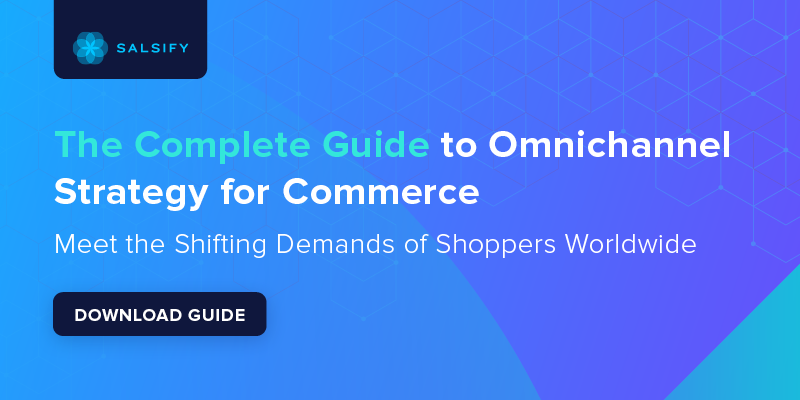

Guide: The Complete Guide to Omnichannel Strategy for Commerce
Empower your omnichannel ecosystem with actionable insights from Salsify’s “Complete Guide to Omnichannel Strategy for Commerce.”
DOWNLOAD GUIDEPIM
Manage all product content in one central system of record.
Syndication
Easily syndicate product content to every consumer touch point.
Enhanced Content
Enrich product pages with below-the-fold content and rich media.
Intelligence Suite
Bring AI-powered capabilities directly into your Salsify workflows.
Grocery Accelerator
Leverage the first-ever category-wide PXM accelerator in the grocery industry.
GDSN Data Pool
Synchronize standard supply chain, marketing, and ecommerce attributes globally.
Digital Shelf Analytics
Continuously optimize your organization’s product content syndication.
Catalog Sites
Share secure, on-brand, and always up-to-date digital product catalogs.
Automation and AI
Automate business processes and enhance Salsify workflows with AI.
PXM Platform, Integrations, and APIs
Integrate the PXM platform with the rest of your enterprise systems architecture.
Supplier Onboarding
Accelerate supplier onboarding while ensuring your schema requirements are met.
Product Listing
Sell products faster with Product Listing.
Content Enrichment
Increase online conversions with Content Enrichment.
Automation
Save time and increase operational efficiency with retail automation.
SXM Platform, Integrations, and APIs
Integrate the SXM platform with the rest of your enterprise systems architecture.
Syndication Network
Automate how you exchange product content data to the digital shelf.
Enhanced Content Network
Turn product pages into product experiences with Enhanced Content.
Commerce Platform Integrations
Create winning product experiences everywhere shoppers are, including on owned sites.
GDSN Data Pool
Synchronize standard supply chain, marketing, and ecommerce attributes globally.
Open Catalog
Connect to the digital shelf faster with an open, standardized, and free product catalog.
Resources
Resource Library
Explore our ecommerce resources to get everything you need to win on the digital shelf.
Blog
Read our blog to get actionable insights for navigating changing markets and industry demands.
Webinars
Watch our on-demand ecommerce webinars to gain expert advice and tips from our community of industry leaders.
Customer Blog
Gain the latest tips, industry trends, and actionable ecommerce insights.
Knowledge Base
Investigate our knowledge base to build your Salsify skills and understanding.
API
Examine our comprehensive API and webhook guides to start working with Salsify quickly.

Download the report to get expert insights, consumer research, and top industry trends.

The average consumer attention span is now shorter, which means consumers will quickly move on to the next experience if they aren’t engaged.
If brands can capture attention in those eight seconds, they can convince users to interact with digital content, explore product options, or make a purchase. Implementing live stream shopping and interactive shoppable video content is a great way to achieve this level of engagement.
You’ll learn the basics and benefits of live stream shopping and shoppable video, discover how users engage with this content, and gain actionable insights for incorporating it into your digital strategy.
Shoppable videos are a form of interactive media content that allows customers to see products in use and purchase them directly from embedded links.
For example, a shoppable video from a cosmetics brand might feature multiple products, such as creams, lotions, or serums being applied, along with information about how products are made and the ingredients they contain. For each product, a link appears on the screen that takes customers directly to its product page. This makes it possible for consumers to move immediately from interest to purchase rather than waiting for links at the end of the video.
@threelittlemingos Replying to @monkeymom96 Have you tried TikTok Shop yet? #garfield #tiktokshop #tiktokmademebuyit #threelittlemingos
♬ original sound - ThreeLittleMingos
Video Source: threelittlemingos TikTok
Live stream shopping, meanwhile, involves the use of a host who demonstrates products on a live video feed. This approach is similar to network television shopping channels but with three notable differences:
@mallowsbeauty Join us LIVE tomorrow at 8pm, CAN’T WAIT TO SEE YOU! 💖#tiktokmademebuyit#tiktokmademebuythis#tiktokliveshop#tiktokliveshopping#onliveshopping#beautybusinessowner#mentalhealthbrand#bodypositivebrand#selflovebaby
♬ original sound - lesley gonzalez 💞
Video Source: mallowsbeauty TikTok
During the live stream, users can ask the host questions about the product, and the host can respond in real time. Customers can click on buy-now links if they’re interested in making a purchase, and these live streams often include product giveaways that increase in value based on the number of users watching.
Live stream shopping is popular on social media apps like TikTok and Facebook and platforms like YouTube. Amazon is also starting to use live stream shopping.
Age and location play critical roles in video shopping engagement.
According to a recent Harris Poll conducted for Sprout Social, 66% of Generation Z and 72% of millennial shoppers say social media is an “essential” part of their lives. These generations are also more likely to use platforms like TikTok or Instagram than their Generation X counterparts — while 74% of Gen Xers also say social media is essential, they prefer platforms like Facebook and YouTube. Meanwhile, just 40% of baby boomers consider social media an essential part of their lives.
When considering your audience, remember that shoppable videos and live streams on platforms like TikTok are more likely to reach Gen Zers and millennials and that Gen Xers prefer YouTube. Baby boomers still prefer more traditional shopping methods.
Geographic location also plays a role in the relevance of video shopping.
For example, live stream shopping sales in the U.S. were expected to top $20 billion in 2022. This is a drop in the bucket compared to the Chinese market, which was expected to reach $423 billion by 2022, according to Influencer Marketing Hub
Efforts are also underway to bring live shopping interactions to Europe. As noted by Fashion Network, luxury French brands like Le Printemps and Monnier Paris have been building live stream platforms that facilitate a personalized, omnichannel experience — which is a priority among luxury buyers.
Location plays a huge factor in how receptive consumers are to live streaming and shoppable video.
Video content offers the dual advantages of garnering interest and elevating immediacy.
For example, Sprout Social’s “Social Media Trends for 2022 & Beyond” report notes that 66% of customers now rate short-form videos as the most engaging type of content in their social feed. Shoppable videos and live stream shopping capitalize on this interest by allowing buyers to immediately purchase what they see on-screen.
These benefits make video a powerful force for product sales, if companies can strike the right balance between sales and interaction. As Fashion Network points out, one major component of a great live stream experience is the right host. Great hosts draw in the audience with a mix of personal charm and product data — choose a less-than-stellar host, and customers will take their views elsewhere.
Live stream shopping and shoppable video aren’t the right fit for every brand.
For example, if your customer base is primarily baby boomers and your brand is headquartered in the U.S., big investments in live shopping may not deliver sustained return on investment (ROI). If you have an engaged social community of Gen Zers, millennials, or Gen Xers, meanwhile, this may be a good fit.
Here, three considerations are critical.
Consumers expect a seamless experience. This means brands need the technology backbone to deliver seamless, high-quality video to keep users engaged.
It’s also critical to deliver consistent content. For example, fashion brands need to ensure that clothing worn by live models is accurately linked on-screen to facilitate purchasing.
Finally, live streams need to help foster a sense of community. This means creating a forum for customers to ask questions and get answers in real-time. If moderators can’t keep up and hosts don’t engage with viewers, impact drops off dramatically.
Live stream shopping and shoppable video can be an integral part of an omnichannel strategy alongside more traditional methods such as email, direct messaging, and social campaigns.
Whether this approach is right for your product or retail brand, however, depends on where you’re selling, who you’re selling to, and how they prefer to connect.

Empower your omnichannel ecosystem with actionable insights from Salsify’s “Complete Guide to Omnichannel Strategy for Commerce.”
DOWNLOAD GUIDEDoug Bonderud (he/him) is an award-winning writer with expertise in ecommerce, customer experience, and the human condition. His ability to create readable, relatable articles is second to none.
Standing out on the digital shelf starts with access to the latest industry content. Subscribe to Below the Fold, our monthly content newsletter, and join other commerce leaders.